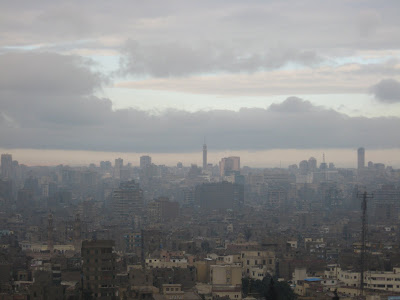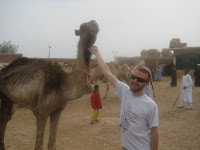As expected, entries on the blog decreased quite drastically this semester, a natural consequence of not traveling to strange places every other week. However, since I still have this forum for talking, and I feel a twinge of guilt whenever I remember I've added a little bit to the electronic wasteland of abandoned blogs, I have resolved to write something. Hopefully, for the next few months at least, I can manage one post a month. This time I'm going to go over the best books I've read in 2010, divided into ten categories. So, without further ado, here are the 2010 Feorag Book Awards.
Best Fiction Recently Written: Let The Great World Spin by Colum McCann
I stumbled across this book at the beginning of the year, and despite a setting (1970's New York) that wouldn't normally capture my attention, I gave it a try. McCann uses Phillipe Petit's tightrope walk across the Twin Towers to connect a variety of stories based in New York City. He sympathetically casts a wide variety of characters, and even though I read the book a year ago most of them are still fresh in my mind. It is a powerful work, and probably more accessible to the average reader than many of the books I'll list.
Best Classic: East of Eden by John Steinbeck
Like nearly every high schooler in America I got my first taste of Steinbeck in high school by reading the Grapes of Wrath and Of Mice and Men. While both are excellent books, I never felt much desire to read East of Eden, probably because the Cain and Abel theme seemed too sober. I finally gave it a try while my family visited Egypt, and while it is large and often dark, I found it to be well worth the effort. Especially enjoyable is Steinbeck's thorough knowledge and love of his California homeland that shine in his descriptions of the Salinas Valley.
Best Western: All The Pretty Horses by Cormac McCarthy
Cormac McCarthy and Larry McMurty may be the only Western authors to have gained widespread respect from the larger literary world, and for good reason. McCarthy's writing isn't always easy to understand, but it works beautifully. All The Pretty Horses takes place in Texas and Mexico, and tracks the difficult journey of a young man whose character is better fit for an earlier time.
Best Science Fiction: The Sparrow by Mary Doria Russell
On a completely different note, this book by Mary Doria Russel explores the possibility of a delegation from Earth visiting an alien race. What is unusual is the nature of the delegation: it is sent by the Vatican and includes several Jesuits. The story is worth reading on its own merits, but it also seeks to explain how religious missions to the American Indians could go so wrong, despite good intentions. The use of two separate timelines isparticularly well-done.
Best Short Story: Shadows by George McDonald
It was a year of short stories for me, especially in the spring when I would listen to one every day on the bus rise between Zamalek and the AUC campus. But my favorite was among the first, one from a collection of fairy tales by McDonald. All of them are good, but two features made Shadows particularly good: the rich imagery and one substory, which poignantly depicts the dangers of solitary brooding.
Best History: The Thirty Years War by CV Wedgewood
The Thirty Years War is one of Europe's most nasty and complex, which makes it a difficult challenge for any historian. Wedgewood rises to the task, and does an excellent job explaining the complexities of 16th century European politics. She also does well in her character portrayals of the war's leading figures, which are generally sympathetic but fair.
Best Biography: St. Francis of Assisi by G.K. Chesterton
I could hardly get through the list without including one work from the prolific Chesterton. Although this book, in typical Chestertonian fashion, can often seem unstructured and unfocused, I believe it manages to really capture the character of St. Francis, as a man who saw the world as it was when it was newly created, and loved it as if it were still that fresh. He also explains how it is natural for such an aescetic man to have great passion for created things.
Best Religious Work: The Cost of Discipleship by Dietrich Bonhoeffer
This book has taken me all year to read in small spurts, largely because it is often difficult work. Bonhoeffer is a thorough theologian with plenty of scriptural and linguistic references, but he is no dusty academic. His life matched the call for action found in this book, which begins with a rallying cry for a true understanding of grace.
Best Re-Read Book: The Brothers Karamazov by Fyodor Dostoevsky
What is one to do with many long hours on a cruiser in July with no job or responsibilities? Read 19th century Russian literature, of course! Brothers Karamazov is probably one of the greatest books every written, and I enjoyed it even more the second time around. All three Karamazov brothers are delightful and endearing in their own ways, and through them the story of a family feud and a trial takes on much greater meaning. Of course, it helps that I read the book for a class the first time, and consequently enjoyed the insights of my professor and fellow students.
Best Poem: Unharvested by Robert Frost
A difficult choice, which could very well change if I made this list on a different day. No commentary, just the poem.
A scent of ripeness from over a wall.
And come to leave the routine road
And look for what had made me stall,
There sure enough was an apple tree
That had eased itself of its summer load,
And of all but its trivial foliage free,
Now breathed as light as a lady's fan.
For there had been an apple fall
As complete as the apple had given man.
The ground was one circle of solid red.
May something go always unharvested!
May much stay out of our stated plan,
Apples or something forgotten and left,
So smelling their sweetness would be no theft.
Thanks for reading the inaugural Feorag Book Awards, and quite possible the only in the series. Hope you all have a wonderful 2011, with at least a few good reads!
























